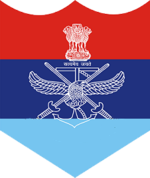Indian armed forces power
Indian Armed Forces
The Indian Armed Forces are the military forces of the Republic of India. It consists of three[12][13] professional uniformed services: the Indian Army, Indian Navy, and Indian Air Force. Additionally, the Indian Armed Forces are supported by the Indian Coast Guard and paramilitary organisations[14] (Assam Rifles, and Special Frontier Force) and various inter-service commands and institutions such as the Strategic Forces Command, the Andaman and Nicobar Command and the Integrated Defence Staff. The President of India is the Supreme Commander of the Indian Armed Forces. The Indian Armed Forces are under the management of the Ministry of Defence (MoD) of the Government of India. With strength of over 1.4 million active personnel,[15][16] it is the world's 2nd largest military force and has the world's largest volunteer army.[17]
It is important to note that the Central Armed Police Forces, which are commonly and incorrectly referred to as 'Paramilitary Forces' based on colonial perspective, are not armed forces. As such they are headed by civilian officers from the Indian Police Service and are under the control of the Ministry of Home Affairs, not the Ministry of Defence. These are central police organisations.
The Indian armed forces have been engaged in a number of major military operations, including: the Indo-Pakistani wars of 1947, 1965 and 1971, the Portuguese-Indian War, the Sino-Indian War, the 1967 Chola incident, the 1987 Sino-Indian skirmish, the Kargil War, and the Siachen conflict among others. India honours its armed forces and military personnel annually on Armed Forces Flag Day, 7 December. Since 1962, the IAF has maintained close military relations with Russia, including cooperative development of programmes such as the Fifth Generation Fighter Aircraft (FGFA) and the Multirole Transport Aircraft (MTA). Armed with the nuclear triad,[18] the Indian armed forces are steadily undergoing modernisation,[19] with investments in areas such as futuristic soldier systems and missile defence systems.[20][19]
The Department of Defence Production of the Ministry of Defence is responsible for the indigenous production of equipment used by the Indian Armed Forces. It comprises the 41 Indian Ordnance Factories under the control of the Ordnance Factories Board, and eight Defence PSUs namely: HAL, BEL, BEML, BDL, MDL, GSL, GRSE and Midhani.[8] India was the largest importer of defence equipment in 2014 with Russia, Israel, France and the United States being the top foreign suppliers of military equipment.[21][22][23] The Government of India has launched a Make in India initiative to indigenise manufacturing and reduce dependence on imports, including defence imports and procurement.

Comments
Post a Comment